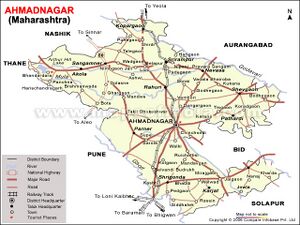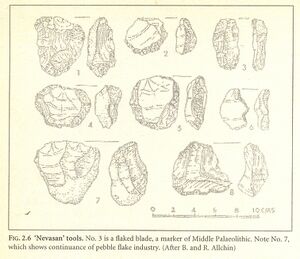Nevasa
| Author:Laxman Burdak, IFS (R) |

Nevasa (नेवासा) is a city in Nevasa tehsil of Ahmednagar district in Maharashtra. Old name of this place are Nidhinivas and Mahalaya.
Variants
- Nevasa/ Newasa नेवासा, (AS, p.507)
- Shrinivasa श्रीनिवास दे. Nevasa नेवास (AS, p.920)
- Navasa नवासा
- Nidhinivas
- Mahalaya
Location
Nevasa is located on Ahmadnagar to Aurangabad Road near the border of the district in north-east corner of the district. This place is near Pravara river also called Amritvahini, a tributary of Godavari River.
Prehistory

Irfan Habib[1] writes that...[p.26] Many sites in south India including Hunsgi valley in Karnataka, and Attirampakkam, near Chennai, have turned up “Early Acheulean tools” (of the so -
[p.27]: called 'Madras industry'), that is, hand axes, etc., made mainly from the cores (see Fig. 2.5).

The U-Th method has yielded dates going back to beyond 350,000 years for sites in Karnataka. Lower Palaeolithic artefacts at Didwana in Rajasthan have been dated by the same means to 390,000 years ago, and at Nevasa in Ahmadnagar district of Maharashtra to 350,000 years ago.
During this process of his diffusion there was a tendency over time for the original Homo erectus to evolve into sub-species that were less robust but more dexterous, and so could make smaller tools out of flakes or the 'Late Acheulean tools'. Remains of such tools have been found in the Narmada valley, where these appear in association with the 'Narmada skull' discovered at Hathnora. This skull, belonging to an evolved Homo erectus could date back to a time earlier than 130,000 years ago. At the famous cave of Bhimbetka in the same area, successive periods of occupation begin with the lowest floors containing Late Acheulean tools.
As Homo erectus evolved, he also improved his tools, giving them new shapes and adjusting the technique to locally available materials. Such changes occurred very slowly, over tens of thousands of years, but these ultimately led to the rise of regional 'cultures'. The term 'culture' is used when archaeologists find at a layer in one or more sites a similar assemblage of tools, ornaments and other products of human labour, which they call 'artefacts', as well as indications of similar customs and beliefs, such as systems of disposing of the dead, and ritual symbols. Regarding Homo erectus, there is little known of custom or belief, and the forms of his stone tools alone supply us with clues to his varied cultures. As the millennia passed, the tendency was for the production of smaller and thinner tools; and the apparently independent appearances of the flake blade in many parts of the world were a natural result of such a tendency. The flake blade is supposed to mark the Middle Palaeolithic stage in India. Such stone blades are found in the 'Nevasa culture' (named after the site of Nevasa already mentioned), which seems to have extended over the southern peninsula and central India (see Fig. 2.6).

At Didwana, the Middle Paeolithic is dated by the TL method to about 150.000 years, ago, but in Gujarat a date as late as 56,800 years ago has been obtained by the U-Th method. In Sri Lanka's southern wet zone, a range of 200,000 to 40,000 years ago has been suggested for it. So the culture may have lasted for a hundred thousand years, if not more. This culture is held to be in direct continuity with the Lower Palaeolithic; and, therefore, its authors were probably the direct descendants of the late Homo erectus, though no skeletal remains have yet been found at any of the sites.
History
The remains of a multilevel settlement dating from the Paleolithic period to the Middle Ages have been discovered at Navasa. Excavations were conducted by H. D. Sankalia in the 1950s and by G. Karve-Corvinus in 1967. Nevasa’s Aeneolithic layer reveals a settled agricultural culture characterized in the second millennium B.C. by implements (elongated plates) similar to those of the Harappa civilization.[2]
In Maharashtra the earliest use of fired bricks and stone in masonry is noticed in the Megalithic culture, Dr. S.B. Deo produces an , account of them as such·-
- "During the Neolithic-Chalcolithic age nowhere the use of fired bricks has been noticed in Maharashtra, but during the ancient historical period, there are evidences in abundance. There was practice of using fired bricks at Nasik, Nevasa, Kolhapur, Kaundinyapur, Prakasha, Bahal during Mauryan Satavahana Age."
Many stone Chetyas and caves were constructed in this age. Similarly Sculptures and many small and large household goods were also shaped from stone in western region of Maharashtra. This period also shows, construction of a very high number of Buddhist stupas and Chetyas in Maharashtra as well as wide spread effect of Buddhism on the masses of Maharashtra. H.L. Kosare puts forward an account of them, [3] :"Many caves and Chetyas were excavated in Karle, Bhaje, Kanheri, Bedsa, Junnar etc, during Satavahana age. An amulet, belonging to the Maurya-Satavahana age bearing the figure of Yaksha has been traced out from Nevasa. Buddhism was in its full swing in those days in Maharashtra.
Mythology and religion
Newasa is also famous as sasurvadi (in laws) of Lord Khandoba, The First wife of Lord Khandoba is from Newasa bk name Mahalasa so khandoba is called Mhalasakant. Due to this pavitra sthal Sant Dnyaneshwar selected this place to write the world famous grantha "Dnyaneshwari" "Bhawarthdipika" a commentary on Bhagavad Gita, popularly known as "Dnyaneshwari".
Saint Dyaneshwar wrote a Dnyaneshwari in Nevasa beside a pole which is still there. Every year palkhi of Dyaneshwari is taken to Pandharpur during ashadi ekadashi.
Mata Laxmi Temple is famous called Varkhedai in village Varkhed, Big Jatra is famous near about 7 to 10 lake people comes there Chaytra vadhy panchami for three days Chabina ceremony held there This Devi called in south name Laxmi-Chandralamba Devi Sannati, Gulbarga Dist
Moryachinchore is a famous village in Newasa Taluka. The More dynasty ruled the village for about 2,000 years. A royal temple of the More dynasty is Pohahicha Mahadev.
In Nevasa there is also a famous village called sukali also known as Gundwadi. In Gundwadi, there is a temple of Shakambhari devi. There is Sureshnagar and Handinimgaon is a village and there is Trivenishwar Mahadev, Temple, Sant Bhakt Prahlad Maharaj.
नेवासा
विजयेन्द्र कुमार माथुर[4] ने लेख किया है ... नेवासा (AS, p.507): प्रवरा नदी के दक्षिणी तट पर स्थित है एक छोटा सा कस्बा है. यह प्राचीन श्रीनिवास क्षेत्र है. नेवासा श्रीनिवास का ही अपभ्रंश है. 1954-55 में पुणे [p.508]: विश्वविद्यालय की ओर से किए गए उत्खनन में यहां 3 सहस्त्र वर्ष प्राचीन सभ्यता के अवशेष प्राप्त हुए हैं. रोम और भारत के व्यापारिक संबंधों के बारे में, उत्खनन द्वारा प्राप्त सामग्री से काफी जानकारी हुई है. संत ज्ञानेश्वर ने गीता पर अपने प्रसिद्ध टीका ज्ञानेश्वरी का श्री गणेश नेवासा में ही किया था. उन्होंने जिन सिलाओं पर ज्ञानेश्वरी को अंकित करवाया था वे आज भी वहां हैं.
प्रवरा नदी
विजयेन्द्र कुमार माथुर[5] ने लेख किया है .....प्रवरा नदी (AS, p.587) के तट पर अनेक प्राचीन स्थान हैं जिनमें श्रीनिवास क्षेत्र या वर्तमान नेवासा प्रमुख है. अन्य स्थान बेलापुर, श्रीवन तथा उक्कल गांव हैं जहां के प्राचीन मंदिर उल्लेखनीय हैं. इस नदी का नाम महाभारत भीष्म पर्व की नदी सूची में है--'करीषिणीं असिक्नीं च कुशचीरां महानदीम्, मकरीं प्रवरां मेनां हेमां घृतवतीं तथा' भीष्म.9,23
References
- ↑ People’s History of India 1, Prehistory, by Irfan Habib, Aligarh Historians Society, Published by Tulika Books, Second Edition, 2002, ISBN: 81-85229-68-6,p.26-27
- ↑ Nevasa: A Type-site for the Study of Indo-Roman Trade in Western India
- ↑ H L Kosare:Prachin Bharatail Nag, p.239
- ↑ Aitihasik Sthanavali by Vijayendra Kumar Mathur, p.507-508
- ↑ Aitihasik Sthanavali by Vijayendra Kumar Mathur, p.587
Back to Maharashtra

